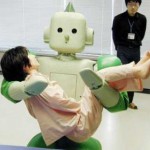(Editor’s Note: This story was originally published May 21, 2010)
The wedding conductor spoke, her arms moving with slow jerky movements, as her large, egg-shaped, glowing eyes flashed from purple to blue to green and yellow.
Strange?

I-Fairy
A Japanese bride and groom recently became the first known couple married by a robot, called I-Fairy, according to The Japan Times.
While the event could be considered cute, if a little odd, discussion about the role of robots in Japanese society is increasing, especially given large demographic shifts expected over the next 40 years.
Japan’s population is shrinking and getting older. According to a report by the Population Reference Bureau (PRB), 23 percent of Japan’s population was 65 years or older as of April 2010.
That number is expected to balloon to about 41 percent by 2055, while the population is predicted to shrink from around 127 million to 90 million people.
With the growing number of elderly, who will take care of them given a dwindling workforce?
A Wired magazine article from January 2010 cited a Japan Machine Industry Memorial Foundation estimate that Japan would save about $21 billion each year using robot nurses to monitor the elderly.

A helper robot
Robots are seen as a potential solution to the population problem versus the politically sticky solution of allowing large numbers of foreign immigrants to fill much-needed health care positions and low-skill service-oriented roles.
One of the largest obstacles to foreign workers is overcoming the Japanese language barrier. A BBC report said that approximately 98 percent of foreign nurses fail a language test required to stay in the country for three years of work.
Foreign workers only make up about two percent of the Japanese population versus about 15 percent in the United States. Some reports suggest the Japanese government has a strong xenophobic attitudes toward immigration.

Japanese health minister demonstrates joystick-controlled "My Spoon"
A United Nations representative said in 2006 that the Japanese government needed to overcome its attitude toward combating racism and xenophobia, according to a Japan Times report.
The government in 2009 unanimously passed laws to encourage higher birth rates among Japanese by trying to remove the “workaholic” aspects of the society, according to the PRB report.
The provisions include increasing the amount of time husbands spend on child care and encouraging workers to use 100 percent of their paid annual leave instead of the current 47 percent average usage.
Past incentive programs like these have resulted in minimum success.
It’s still unknown whether Japan will choose a long-term solution to its population issues by allowing more foreign workers or increased use of robots.
—Don Clyde/Newsdesk
VIDEO: RIBA – Robot Assistant
VIDEO: I-Fairy marries Japanese couple
CITATIONS:
I-Fairy robot leads events at Tokyo wedding
The Japan Times Online, May 18, 2010
Japan may pick robots over immigrants
BBC News, May 17, 2010
Newsweek.com, April 30, 2010
Population Reference Bureau, Japan’s Demographic Future, Carl Haub, May 2010
Robot Nurses to Care for Japanese Elderly within Five Years
zybotics.com, March 27, 2009
Racism rapporteur repeats criticism
The Japan Times Online, May 18, 2006
Robots could do work of 3.5 million people by ’25
The Japan Times Online, April 4, 2008
Robots seen as solution to Japan’s aging, shrinking population…. great technology about to know those things.
Confused world. Terminator in the making. I hope you guys are ready to fight off the robots when they get smarter.